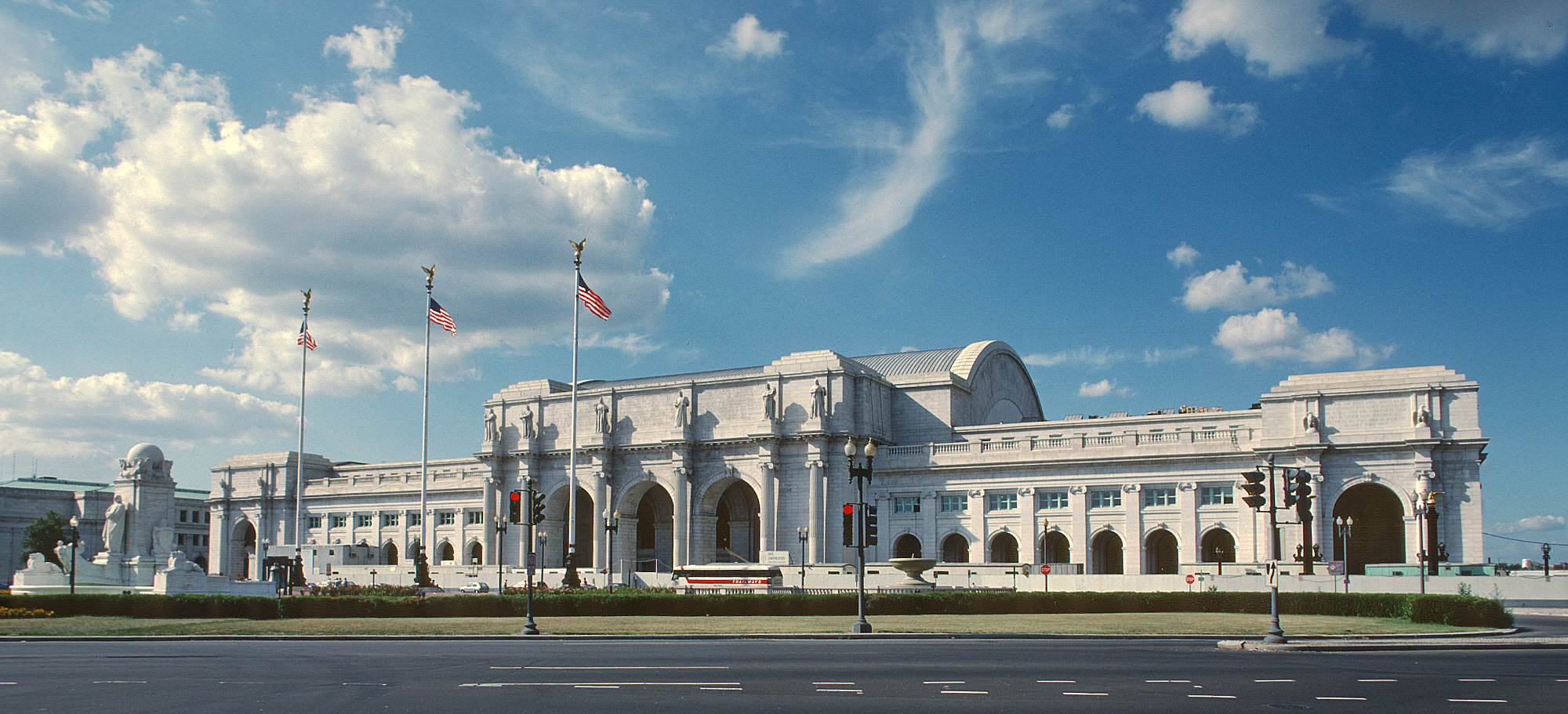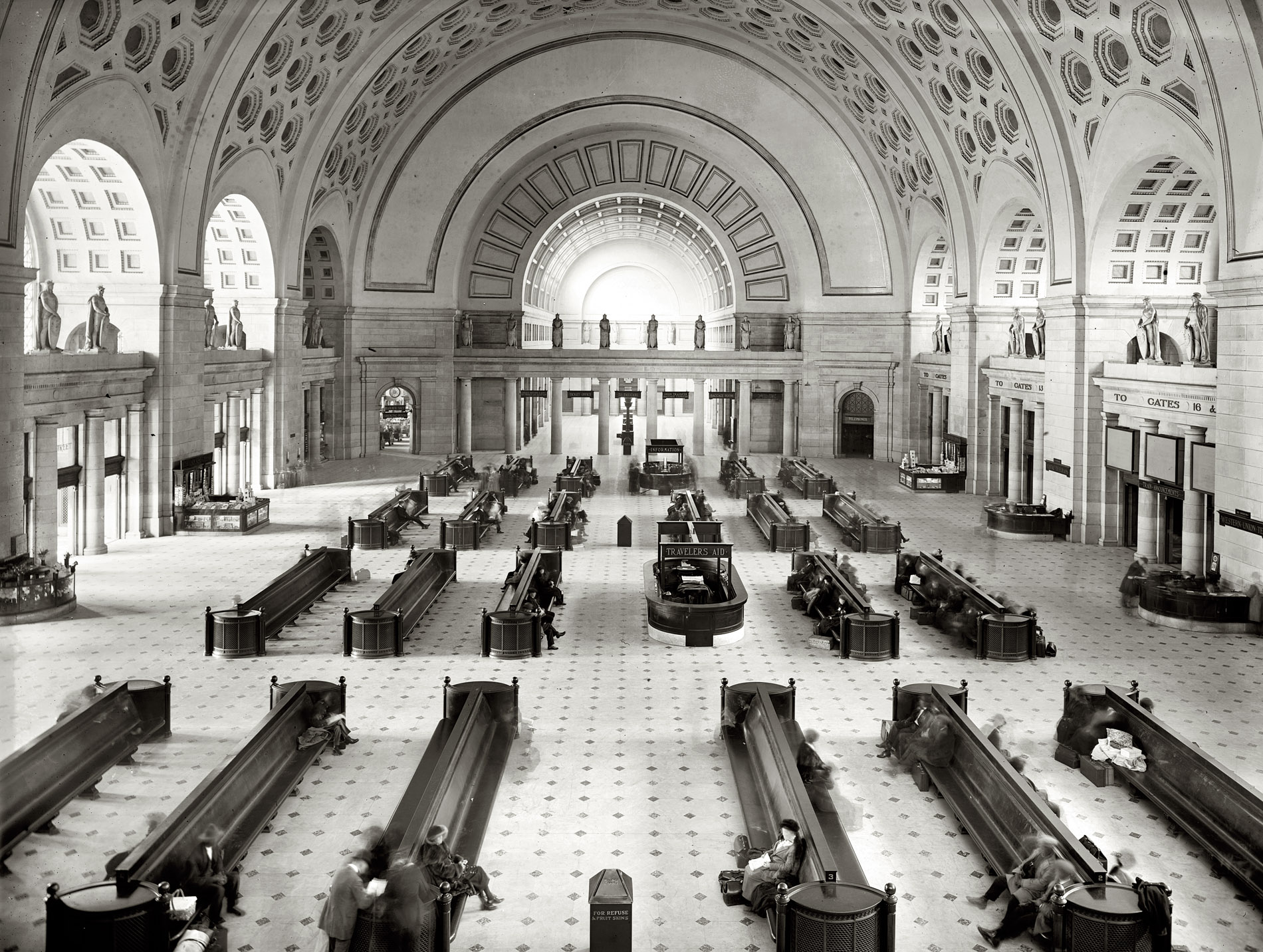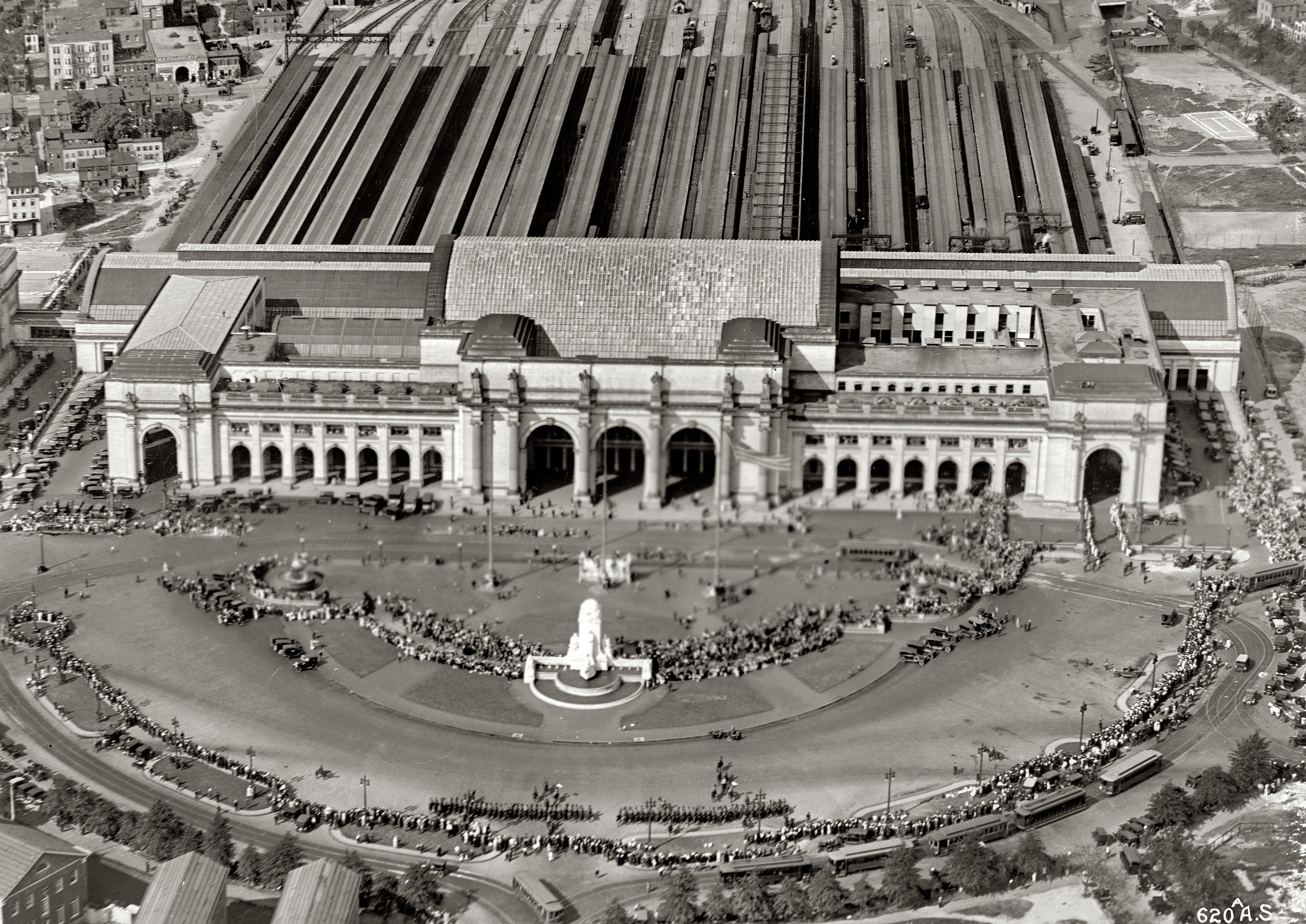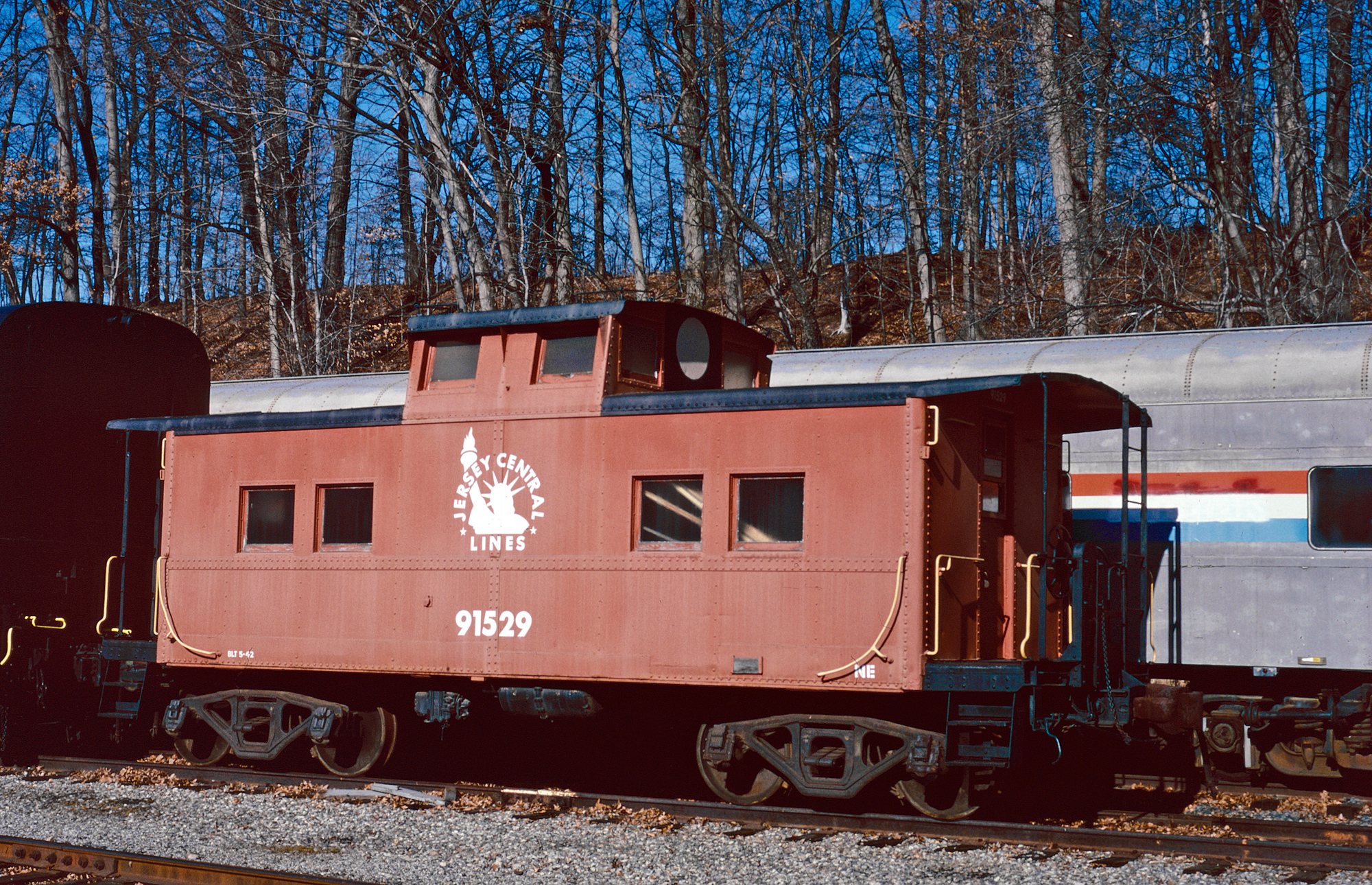Washington Union Station: Photos, History, Current Use
Last revised: September 10, 2024
By: Adam Burns
Washington Union Station is a major train station, transportation hub, and leisure destination in Washington, D.C.
Opened in 1907, it is Amtrak's headquarters and the railroad's second-busiest station with annual ridership of just under 5 million and the ninth-busiest in overall passengers served in the United States.
The station also serves as a commuter rail hub, and it offers connections to the Washington Metro and buses. It houses various restaurants, shops, and a popular food court.
 The grand Washington Union Station as seen on August 15, 1987. It was opened in 1907 and remains in regular use today. Roger Puta photo.
The grand Washington Union Station as seen on August 15, 1987. It was opened in 1907 and remains in regular use today. Roger Puta photo.Construction
The grand and historic Washington Union Station, a significant part of the United States railway network, is a marvel of American architectural prowess. This station, the brainchild of celebrated architect Daniel Burnham, stands as a testament to his innovative ideas and ability to envision structures that blend form and function.
Work on the imposing edifice commenced in 1903, and on October 27, 1907, the station officially opened its gates to the public.
Cost
The cost of building this monumental structure is an aspect that highlights its significant economic investment, as it totaled over $25 million—a staggering sum in the early 20th century.
Architecturally, Washington Union Station is an eclectic amalgamation of styles. However, it predominantly illustrates the influence of the grand classical Beaux-Arts architectural tenets, embodying grandeur, and meticulous detailing.
Constructed chiefly of white granite from Bethel, Vermont, the station presents a striking picture of solidity and enduring resilience.
Perfectly situated at 50 Massachusetts Avenue NE, Washington, D.C., the station's location was selected with strategic intention—it sits on the city's central axis, directly in line with the U.S. Capitol.
The station houses a staggering 18 tracks with nine platforms in the main terminal (originally 30 tracks with 18 platforms), reflecting its monumental capacity for handling substantial rail traffic.
During Washington Union Station's peak years in the mid-20th century, it served an estimated 200,000 passengers daily (World War II), and nearly 200 trains departed from its platforms each day.
In 1981, Amtrak purchased the station and became the primary service provider. This marked a critical turning point in the station's long and varied history.
Today, Washington Union Station accommodates more than 40,000 passengers every weekday, and according to Amtrak's statistics, it handles over 5 million passengers annually.
Presently, Washington Union Station is served by several Amtrak trains offering an extensive network of routes. Notably, it's a pivotal stop along the Northeast Corridor route, which includes the high-speed Acela Express, Northeast Regional, and Palmetto services. Many long-distance routes, such as the Capitol Limited, Cardinal, Crescent, Silver Service, and Vermonter also serve this station.
The station is not solely devoted to Amtrak operations. Washington Union Station also accommodates Washington Metro's Red Line and several MARC and VRE commuter train services. Altogether, it fulfils the role of a vital intermodal transport hub in the heart of the nation's capital.
At A Glance
The station has seen quite a few transformative phases in its century-long history. After the sale to Amtrak, the station underwent considerable refurbishment in the late '80s to restore its former glory and accommodate modern amenities.
Washington Union Station, even beyond its functional role as a transportation hub, holds historical significance. Recognized as a national historic site by the United States National Register of Historic Places, the station is a living ode to the country's rich architectural and railway history.
The importance of Washington Union Station today goes beyond being a significant railway station. It is integrated into the fabric of Washington, D.C.'s life with several shopping options, dining facilities, and events that cater to millions of visitors each year.
A significant part of Washington Union Station's appeal is its beautiful architectural elements, including the magnificent coffered ceiling in the Main Hall, intricate sculptures, grand arches, and marble floors, which offer a glimpse into the past and present of American architecture.
Another architectural highlight is the colossal statue, the "Monument to Columbus," which was a gift from the people of Italy, standing over forty-five feet high in the station's Main Hall.
Besides train services, Washington Union Station is a major bus terminal, providing passengers with Megabus, BoltBus, and Greyhound services. This multifunctional aspect enhances its role as a central transportation hub.
 Washington Union Station's waiting room, circa 1922. National Photo Company Collection glass negative.
Washington Union Station's waiting room, circa 1922. National Photo Company Collection glass negative.Today
Today, the station building also houses the popular Union Station Shopping Mall attracting locals and tourists alike, thereby transforming this transport hub into a thriving commercial zone.
Washington Union Station's central location and proximity to various city attractions, including the National Mall, U.S. Capitol and various museums, increases its significance as a transportation hub.
Over the years, Washington Union Station played a significant role in the nation's events, welcoming presidents and royalty, celebrities, and the public who attended grand balls, Presidential inaugurations, and World War II USO shows.
Future plans for Washington Union Station aim at improving its capacity and amenities to accommodate growing demand, with substantial expansions and architectural restorations projected to span several decades.
The impact of Washington Union Station extends into popular culture, with the station featuring prominently in films, television, and literature.
The station has been a witness to the evolution of train travel in the United States, from the grand era of steam to today's sleek and high-speed trains, earning it a unique place in American railway history.
Overall, Washington Union Station continues to play a pivotal role in linking the nation’s capital with the rest of the United States, embodying the spirit of travel, exploration, and human connectivity that lies at the core of railway history. Its rich history, architectural grandeur, and modern convenience in service make it a must-visit for travelers and history enthusiasts alike.
In addition to the designated Amtrak services, Washington Union Station also facilitates the international Thruway Motorcoach services, ensuring further connectivity.
As of today, there are plans to introduce more high-speed train services at the station, emanating the station's commitment to adapting to the continual advancements in railway technology.
Serving as a pivotal transportation hub in Washington D.C., the station offers direct accessibility to the city's Metro network, seamlessly connecting passengers to various parts of the city.
Washington Union Station houses offices for Amtrak's corporate headquarters, further substantiating its central role in Amtrak operations.
The station is also a base for several annual community events, such as National Train Day celebrations, facilitating public engagement and fostering a community spirit around railways and train travel.
Its food court offers a variety of food and beverage options, making it a favorable spot for commuters and tourists to enjoy local and international cuisine.
The pedestrian concourse at Washington Union Station is the bustling heart of the station, where travelers, city locals, and tourists mingle amidst the grandeur of this hundred-year-old structure.
Over the years, the station has faced and braved several calamities, including a fire in 1981 and an earthquake in 2011, but it has always emerged stronger and more resilient, reflecting the indomitable spirit of Washington, D.C.
Offering Bike & Ride facilities, Washington Union Station supports sustainable commuting options, aligning with the city's goal of promoting eco-friendly transportation.
Washington Union Station's dignified Presidential Suite, once used to welcome U.S. Presidents, serves now as an exclusive venue for private events and ceremonies.
Art enthusiast or not, one cannot overlook Louis St. Gaudens' splendid sculptures, 'The Progress of Railroading', which adorn the station's facade and captivate passersby with their beauty and intricacy.
Current Visitors
With more than 40 million visitors annually, Washington Union Station isn't merely a transportation hub; it is a monument, a shopping destination, a center of activity, and one of Washington, D.C.’s perennial tourist attractions.
Despite the advent of air travel and a network of highways, Washington Union Station remains a potent symbol of America's enduring love affair with train travel, connecting people and places across the nation.
Standing tall and proud in the heart of the U.S. capital, Washington Union Station is a testament to the city’s storied past and a symbol of its vibrant present.
Today, Union Station is not just a place where journeys begin or end, but it is a journey within itself—one steeped in history, craftsmanship, and the constant hum of human activity.
Despite the challenges that come with time, the station's future looks promising with proposed restoration and expansion plans aiming to ensure its relevance and utility in tomorrow's transportation landscape.
Legacy
The station houses the Presidential Gallery, showcasing the history of U.S. Presidential Inaugural Balls, which were traditionally held in the station's ornate waiting rooms, providing a visual journey through significant moments of American history.
Indeed, woven into the very fabric of Washington, D.C.'s historical and cultural narrative, the Washington Union Station has truly stood the test of time, emerging as an enduring symbol of this great city's heart and soul.
To conclude, Washington Union Station is more than a railway station; it's a remarkable testament to the indomitable spirit of progress, intricately connected to the past, serving the present, and looking towards the future.
Its legacy continues to define and influence railway operations and architectural sensibilities, underscoring its relevance in modern-day Washington, D.C., and the United States.
Recent Articles
-
Oregon Railroad Museums: A Complete Guide
Apr 25, 25 03:11 PM
With its rich tapestry of scenic landscapes and profound historical significance, Oregon possesses several railroad museums that offer insights into the state’s transportation heritage. -
North Carolina Railroad Museums: A Complete Guide
Apr 25, 25 02:56 PM
Today, several museums in North Caorlina preserve its illustrious past, offering visitors a glimpse into the world of railroads with artifacts, model trains, and historic locomotives. -
New Jersey Railroad Museums: A Complete Guide
Apr 25, 25 11:48 AM
New Jersey offers a fascinating glimpse into its railroad legacy through its well-preserved museums found throughout the state.


